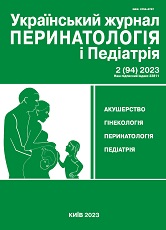Difficulties in the diagnosis of histiocytic necrotizing lymphadenitis
DOI:
https://doi.org/10.15574/PP.2023.94.135Keywords:
children, histiocytic necrotising lymphadenitis, immunohistochemical examination, diagnosisAbstract
There is currently no consensus on the origin of histiocytic necrotising lymphadenitis (HNL), which is traditionally thought to be a self-limited, benign condition that usually resolves within 6 months. It is important to distinguish HNL as a clinical nosology because it can mimic other diseases such as lymphoma, infectious (mostly viral) and autoimmune diseases, including systemic lupus erythematosus. According to one study, HNL is misdiagnosed as lymphoma in 30% of cases. It has seen a similar clinical case in own practice.
Purpose - to highlight the thoroughness of the diagnostic algorithm and differential diagnosis in case of suspected HNL.
The article presents a clinical case of HNL in a 9-year-old child, which showed the complexity of clinical diagnosis. This observation combined the characteristic symptoms of the disease (fever, lymphadenopathy, hepatomegaly), haematological markers (leukemia, thrombocytopenia, anemia, accelerated erythrocyte sedimentation rate), as well as rare manifestations. There was a progressive development of edematous syndrome, which was manifested first by peripheral manifestations, and then bilateral pleurisy, ascites, soft tissue edema with the development of anasarca progressively increased.
The difficulty in the diagnostic algorithm was that the first two histological examinations suggested the possibility of lymphoma in the child, and later immunohistochemical examination of the lymph node allowed to verify the clinical diagnosis. Obviously, a labour-intensive differential diagnosis in HNL requires the exclusion of the subject range of possible diseases of infectious or autoimmune origin.
Conclusions. The diagnosis of HNL in the above observation was characterized by the complexity of the interpretation of clinical, morphological, histological studies, and only the result of immunohistochemical examination allowed to establish the diagnosis. In practice, the paediatrician should be properly aware of this pathology in order to refer the child to a paediatric hematologist in a timely manner. In the presence of a complex of clinical symptoms (prolonged fever, lymphadenopathy, rash, neurological symptoms), the possibility of a diagnosis of HNL should be considered.
The study was performed in accordance with the Declaration of Helsinki. The informed consent of the child's parents was obtained for the study.
The author declares no conflict of interest.
References
Arslan A, Kraus CL, Izbudak I. (2020). Optic Neuritis as an Isolated Presentation of Kikuchi-Fujimoto Disease in a Pediatric Patient. Balkan Med J. 37 (3): 172-173. https://doi.org/10.4274/balkanmedj.galenos.2019.2019.11.88; PMid:31876134 PMCid:PMC7161621
Baek JY, Kang JM, Lee JY et al. (2022). Comparison of Clinical Characteristics and Risk Factors for Recurrence of Kikuchi-Fujimoto Disease Between Children and Adult. J Inflamm Res. 15: 5505-5514. https://doi.org/10.2147/JIR.S378790; PMid:36172546 PMCid:PMC9512633
Dorosh OI, Stegnitska MV, Petronchak OA et al. (2019). Kikuchi-Fujimoto disease: features of diagnosis and clinical course. Modern Pediatrics. Ukraine. 8 (104): 71-82. https://doi.org/10.15574/SP.2019.104.71
Garcia-Zamalloa A, Taboada-Gomez J, Bernardo-Galán P et al. (2010). Bilateral pleural effusion and interstitial lung disease as unusual manifestations of Kikuchi-Fujimoto disease: case report and literature review. BMC Pulm Med. 10: 54. https://doi.org/10.1186/1471-2466-10-54; PMid:21054856 PMCid:PMC2991292
Hua CZ, Chen YK, Chen SZ et al. (2021). Histiocytic Necrotizing Lymphadenitis Mimicking Acute Appendicitis in a Child: A Case Report. Front Pediatr. 9: 682738. https://doi.org/10.3389/fped.2021.682738; PMid:34604132 PMCid:PMC8484880
Ikeda K, Kakehi E, Adachi S, Kotani K. (2022). Kikuchi-Fujimoto disease following SARS-CoV-2 vaccination. BMJ Case Rep. 15 (11): e250601. https://doi.org/10.1136/bcr-2022-250601; PMid:36414349 PMCid:PMC9685266
Inamo Y. (2020). The Difficulty of Diagnosing Kikuchi-Fujimoto Disease in Infants and Children Under Six Years Old: Case Report and Literature Review. Cureus. 12 (3): e7383. https://doi.org/10.7759/cureus.7383; PMid:32337111 PMCid:PMC7179985
Kim HY, Jo HY, Kim SH. (2021). Clinical and Laboratory Characteristics of Kikuchi-Fujimoto Disease According to Age. Front Pediatr. 9: 745506. https://doi.org/10.3389/fped.2021.745506; PMid:34796153 PMCid:PMC8593182
Kim L, Tatarina-Numlan O, Yin YD et al. (2020). Case of Kikuchi-Fujimoto Disease in a 7-Year-Old African American Patient: A Case Report and Review of Literature. Am J Case Rep. 21: e922784. https://doi.org/10.12659/AJCR.922784
Lelii M, Senatore L, Amodeo I et al. (2018). Kikuchi-Fujimoto disease in children: two case reports and a review of the literature. Ital J Pediatr. 44 (1): 83. https://doi.org/10.1186/s13052-018-0522-9; PMid:30021595 PMCid:PMC6052688
Pan YT, Cao LM, Xu Y et al. (2021). Kikuchi-Fujimoto Disease With Encephalopathy in Children: Case Reports and Literature Review. Front Pediatr. 9: 727411. https://doi.org/10.3389/fped.2021.727411; PMid:34660488 PMCid:PMC8519585
Richards MJ. (2022). Kikuchi disease. URL: https://www.uptodate.com/contents/kikuchi-disease?search=Kikuchi-Fujimoto%20disease&source=search_result&selectedTitle=1~30&usage_type=default&display_rank=1#references.
Saito Y, Suwa Y, Kaneko Y et al. (2022). Kikuchi-Fujimoto Disease Following COVID-19 Infection in a 7-Year-Old Girl: A Case Report and Literature Review. Cureus. 14 (7): e26540. https://doi.org/10.7759/cureus.26540
Singh JM, Shermetaro CB. (2019). Kikuchi-Fujimoto Disease in Michigan: A Rare Case Report and Review of the Literature. Clin Med Insights Ear Nose Throat. 12: 1179550619828680. https://doi.org/10.1177/1179550619828680; PMid:30833818 PMCid:PMC6393831
Song Y, Liu S, Song L et al. (2021). Case Report: Histiocytic Necrotizing Lymphadenitis (Kikuchi-Fujimoto Disease) Concurrent With Aseptic Meningitis. Front Neurol. 12: 565387. https://doi.org/10.3389/fneur.2021.565387; PMid:33959084 PMCid:PMC8093430
Wang S, Du B, Li X, Li Y. (2021). Positron emission tomography/computed tomography hypermetabolism of Kikuchi-Fujimoto disease mimicking malignant lymphoma: a case report and literature review. J Int Med Res. 49 (7): 3000605211032859. https://doi.org/10.1177/03000605211032859; PMid:34334002 PMCid:PMC8326629
Downloads
Published
Issue
Section
License
Copyright (c) 2023 Ukrainian Journal of Perinatology and Pediatrics

This work is licensed under a Creative Commons Attribution-NonCommercial 4.0 International License.
The policy of the Journal “Ukrainian Journal of Perinatology and Pediatrics” is compatible with the vast majority of funders' of open access and self-archiving policies. The journal provides immediate open access route being convinced that everyone – not only scientists - can benefit from research results, and publishes articles exclusively under open access distribution, with a Creative Commons Attribution-Noncommercial 4.0 international license(СС BY-NC).
Authors transfer the copyright to the Journal “MODERN PEDIATRICS. UKRAINE” when the manuscript is accepted for publication. Authors declare that this manuscript has not been published nor is under simultaneous consideration for publication elsewhere. After publication, the articles become freely available on-line to the public.
Readers have the right to use, distribute, and reproduce articles in any medium, provided the articles and the journal are properly cited.
The use of published materials for commercial purposes is strongly prohibited.

